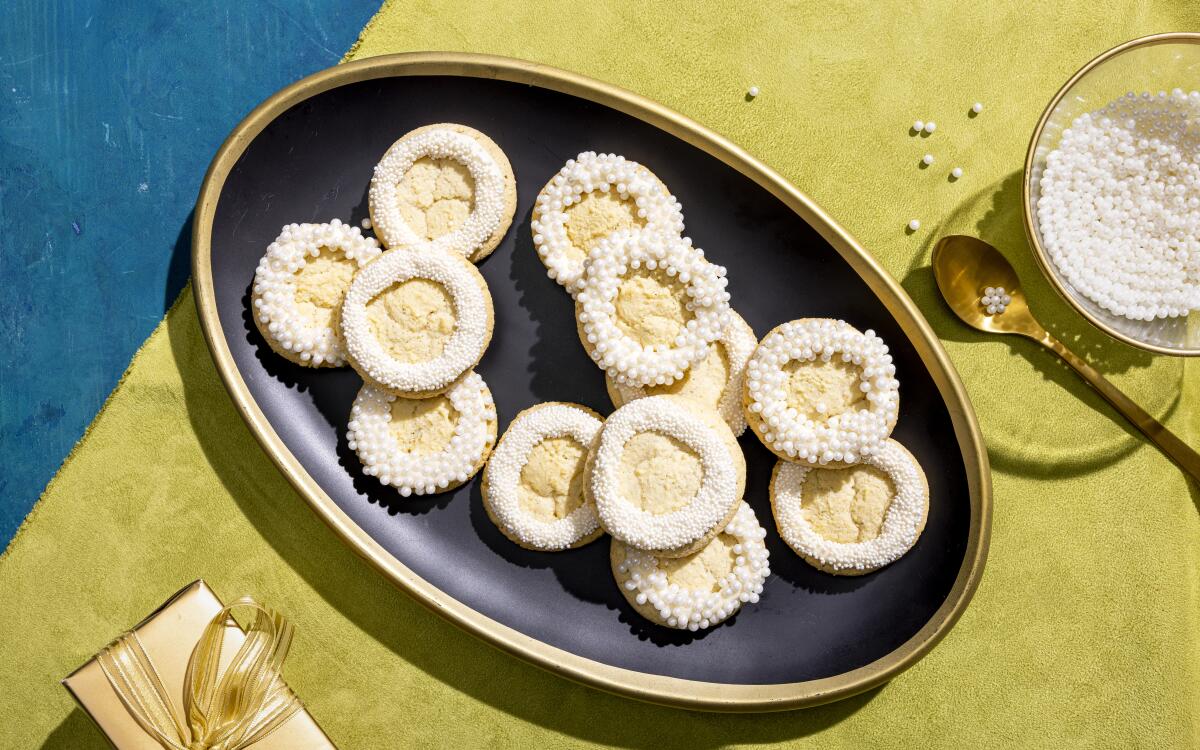Eggnog Dreams

- Share via
Inspired by Swedish drömmar (“dream”) cookies, these light-as-air, eggnog-flavored cookies are ideal for anyone who loves the creamy, spiced flavor of the holiday tipple. Egg yolks, nutmeg, a pinch of cloves and a splash of rum extract work together to intensify the flavor of eggnog in these cookies. They’re great on their own, but if you want to make the frosting, they make for beautiful “wreath” cookies, especially when coated in pearl or cream-colored dragées, sprinkles or sparkling sugar. The baker’s ammonia (see note below) can be found at King Arthur Baking Co. or on Amazon, but if you don’t want to procure it, baking powder will work as a substitute. However, it will give the cookie a chewier texture rather than the crisp and delicately brittle one the baker’s ammonia provides.
Heat the oven to 300 degrees. Line two large baking sheets with parchment paper. In a medium bowl, whisk together the almond flour, nutmeg, salt and cloves.
In the bowl of a stand mixer or in a large bowl and using a handheld mixer, combine the sugar and butter and beat on medium speed until pale and fluffy, about 3 minutes. Add the egg yolks one at a time, beating well between each addition, followed by the whole egg. Beat in the rum extract, if using.
Add the dry ingredients to the bowl and beat on low speed until just combined; turn off the mixer. Quickly measure out and sift the baker’s ammonia into the dough, then mix on low speed for 30 seconds to ensure it is evenly incorporated into the dough. Use a large silicone spatula to scrape down the sides of the bowl to ensure the dough is evenly mixed.
Using a 1/2-ounce ice cream scoop or tablespoon-size measuring spoon, scoop the dough and arrange the dough balls on the prepared baking sheets, spaced evenly apart (12 to each sheet).
Working with one sheet at a time, bake the cookies, rotating the sheet halfway through cooking, until they crack on top and are just beginning to brown at the edges, 20 to 22 minutes. Transfer the sheet to a wire rack and let the cookies cool completely on the sheet. Repeat with the second baking sheet and dough to make more cookies.
If using the frosting, combine the butter, nutmeg and salt in a bowl and beat on medium speed until smooth. Add the powdered sugar and beat until it forms a stiff frosting. With the mixer on low, pour in 3 tablespoons heavy cream and beat until the frosting is smooth and spreadable, adding the remaining tablespoon of cream, if needed. Scrape the frosting into a piping bag fitted with a 1/4-inch plain tip.
Pour the sprinkles into a wide, shallow bowl. Pipe a ring of frosting around the top edge of the cookies, creating a border. Pick up the cookie and dip the frosting ring gently in the bowl of sprinkles so they coat it completely and evenly. Return the cookie right side up to the baking sheet and let stand until the frosting stiffens and sets. Repeat with the remaining cookies.
Once the chief ingredient in smelling salts, ammonium carbonate has a stench that, if you own a cat, you are familiar with. (In Marcus Nilsson’s recipe for drömmar, or Swedish dream cookies, in his cookbook “The Nordic Baking Book” (Phaidon, 2018), he refers to the leavening agent as “piss salt.”) Thankfully, when heated, ammonium carbonate decomposes into two chemicals: carbon dioxide, which leavens the dough, and ammonia, which dissipates, leaving no aroma behind in the finished product. It works best in cookies and thin crackers where there’s plenty of surface area for the ammonia to dissipate and where an exceedingly crisp texture is desired.
Baker’s ammonia is still available to provide that authentic texture in old-school European baked goods, especially the aforementioned Swedish dream cookies, from which my Eggnog Dreams take their inspiration. The cookies are called dreams because they dissolve quickly in your mouth, thanks to their lighter-than-air texture and honeycomb-like crumb courtesy of the baker’s ammonia. Ammonium carbonate is available through King Arthur Baking Co. and on Amazon, but if you don’t want to go through the trouble of procuring it, you can easily substitute it with baking powder. However, the texture of the finished cookie will be crisp outside and slightly chewy inside as opposed to meltingly brittle and crisp throughout with the baker’s ammonia.
If you’re going to work with baker’s ammonia, though, know that now is a great time since you already have an item that will make handling it more pleasurable: a face mask. Simply put on your face mask and, to prevent any malodorous smell from lingering, open a window in your kitchen while measuring it and portioning and baking the dough.
Get our Cooking newsletter.
Your roundup of inspiring recipes and kitchen tricks.
You may occasionally receive promotional content from the Los Angeles Times.















